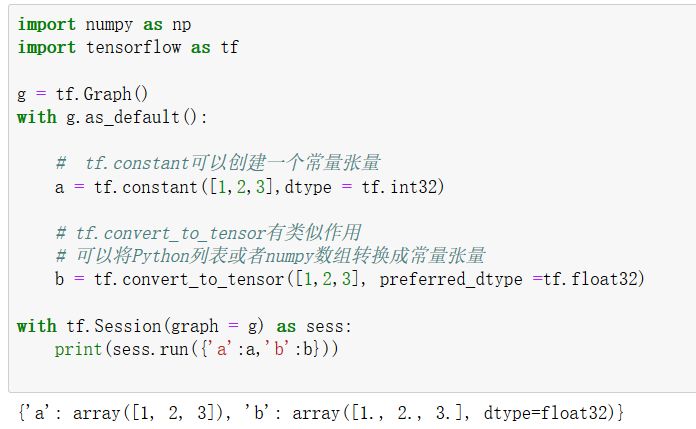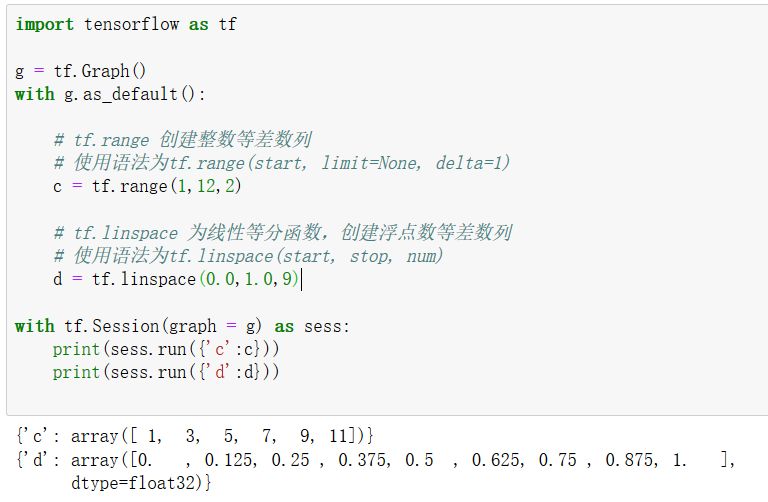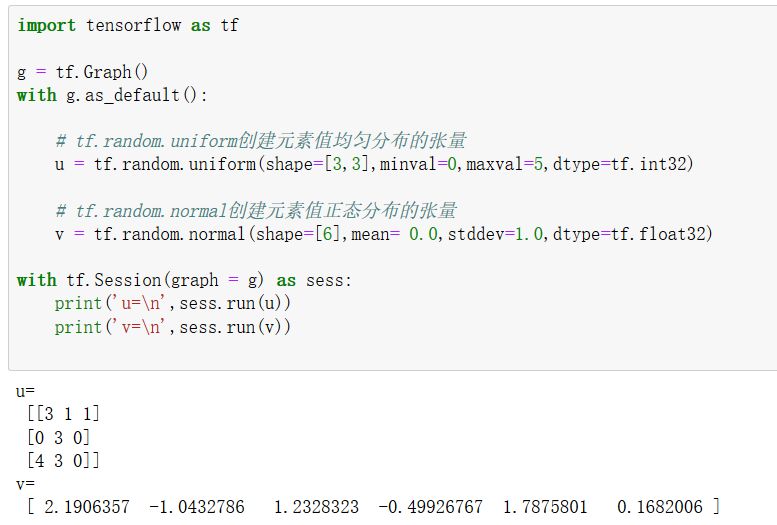您好,登录后才能下订单哦!
密码登录
登录注册
点击 登录注册 即表示同意《亿速云用户服务条款》
TensorFlow基础中的常量是什么,相信很多没有经验的人对此束手无策,为此本文总结了问题出现的原因和解决方法,通过这篇文章希望你能解决这个问题。
下面介绍TensorFlow中与常量相关的几个函数:
tf.constant #常量张量
tf.convert_to_tensor #转换成张量
tf.range #整数等差
tf.linspace #线性等分
tf.random.uniform # 均匀分布
tf.random.normal #正态分布
示范1:
import numpy as np
import tensorflow as tf
g = tf.Graph()
with g.as_default():
# tf.constant可以创建一个常量张量
a = tf.constant([1,2,3],dtype = tf.int32)
# tf.convert_to_tensor有类似作用
# 可以将Python列表或者numpy数组转换成常量张量
b = tf.convert_to_tensor([1,2,3], preferred_dtype =tf.float32)
with tf.Session(graph = g) as sess:
print(sess.run({'a':a,'b':b}))
输出结果如下:

示范2:
import tensorflow as tf
g = tf.Graph()
with g.as_default():
# tf.range 创建整数等差数列
# 使用语法为tf.range(start, limit=None, delta=1)
c = tf.range(1,12,2)
# tf.linspace 为线性等分函数,创建浮点数等差数列
# 使用语法为tf.linspace(start, stop, num)
d = tf.linspace(0.0,1.0,9)
with tf.Session(graph = g) as sess:
print(sess.run({'c':c}))
print(sess.run({'d':d}))
输出结果如下:

示范3:
import tensorflow as tf
g = tf.Graph()
with g.as_default():
# tf.random.uniform创建元素值均匀分布的张量
u = tf.random.uniform(shape=[3,3],minval=0,maxval=5,dtype=tf.int32)
# tf.random.normal创建元素值正态分布的张量
v = tf.random.normal(shape=[6],mean= 0.0,stddev=1.0,dtype=tf.float32)
with tf.Session(graph = g) as sess:
print('u=\n',sess.run(u))
print('v=\n',sess.run(v))
输出结果如下:

此外,有许多与numpy中类似的函数也可以用来创建常量张量。
例如 tf.zeros,tf.ones,tf.zeros_like,tf.diag ...
看完上述内容,你们掌握TensorFlow基础中的常量是什么的方法了吗?如果还想学到更多技能或想了解更多相关内容,欢迎关注亿速云行业资讯频道,感谢各位的阅读!
免责声明:本站发布的内容(图片、视频和文字)以原创、转载和分享为主,文章观点不代表本网站立场,如果涉及侵权请联系站长邮箱:is@yisu.com进行举报,并提供相关证据,一经查实,将立刻删除涉嫌侵权内容。